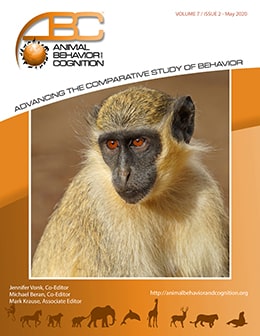Vol 7, Issue 2, May 2020
Nonhuman Primate Alarm Calls Then and Now
Citation
Fischer, J. (2020). Nonhuman primate alarm calls then and now. Animal Behavior and Cognition, 7(2), 108-116. doi: https://doi.org/10.26451/abc.07.02.05.2020
Abstract
Against the background of the seminal papers on the vervet monkey alarm call system by Seyfarth, Cheney and Marler (1980a. 1980b), I provide an overview of context specificity in calling and call comprehension learning in the genus Chlorocebus, and to which degree these findings inform the reconstruction of the evolution of speech and language. The alarm calls of vervet monkeys (Chlorocebus pygerythrus) and West African green monkeys (Chlorocebus sabaeus) are astoundingly similar in terms of the structure of calls given in response to their main predator types. Green monkeys also spontaneously produced calls that sounded like ‘eagle alarms’ in response to a novel aerial threat (a drone), supporting the view that both the link between the predator category and the call, as well as the call structure itself are largely hard-wired. In contrast, learning shapes the responses to sounds. As recent field experiments showed, monkeys are able to rapidly attach meaning to a novel sound, and they are also able to factor in contextual information when choosing their responses. These findings corroborate the view of a fundamental dichotomy in the degree of flexibility in terms of the production of calls with a specific structure vs. the comprehension of calls and suggest that the emergence of auditory learning abilities preceded the evolution of flexible vocal production. In summary, nonhuman primate communication shares fewer similarities with human speech than many scholars may have hoped for, but we would never have learned so much about primate vocal communication were it not for the breakthrough study by Seyfarth, Cheney, and Marler.
Keywords
Alarm call, Chlorocebus, Meaning, Referential communication, Primate, Vervet monkey
